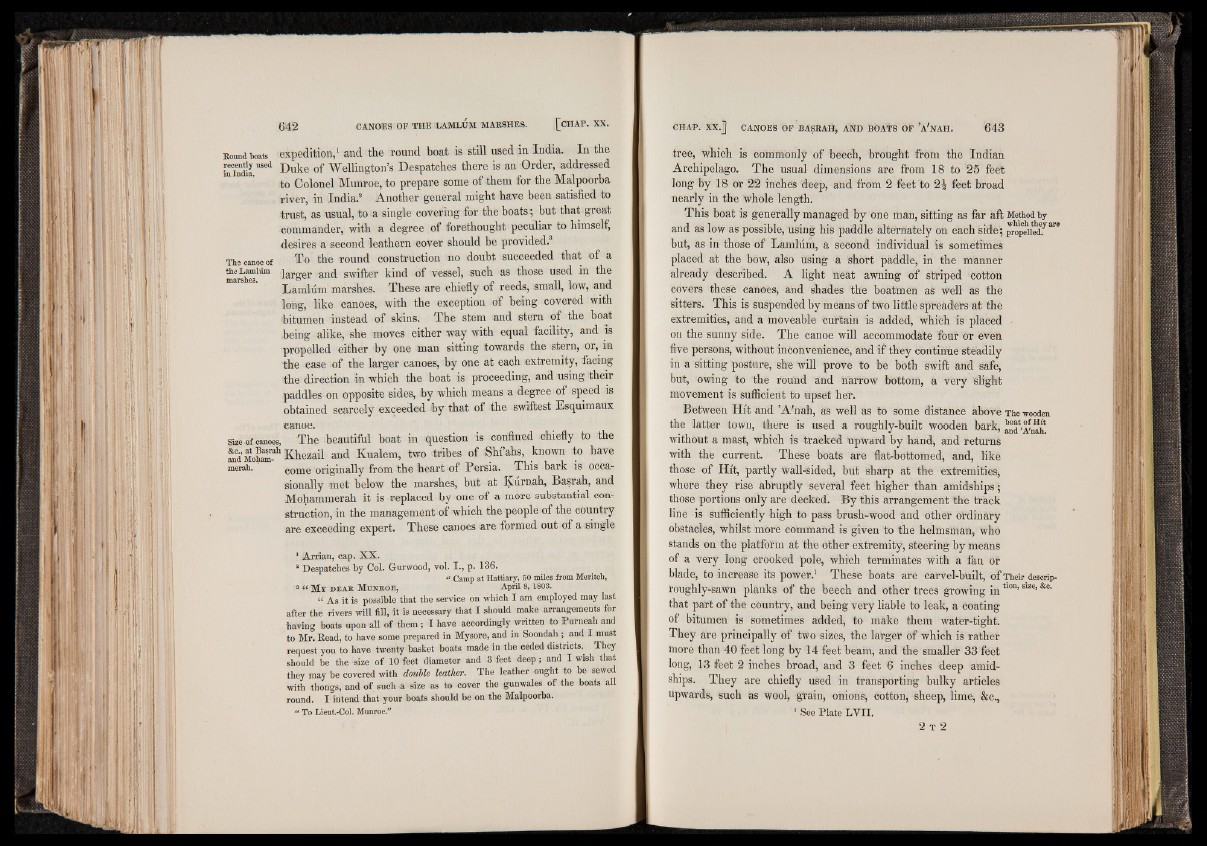
Bound boats expedition,1 and the round boat is still used in India. In the
F“endm ■ Duke of Wellington’s Despatches there is an Order, addressed
to Colonel Munroe, to prepare some of them for the Malpoorba
river, in India.8 Another general might have been satisfied to
trust, as usual, to a single covering for the boats.; but that great
commander, with a degree of forethought peculiar to himself,
desires a second leathern cover should be provided.3
The canoe of To the round construction no doubt succeeded that of a
maihS1™ larger and swifter kind of vessel, such as those used in the
Lamlum marshes. These are chiefly of reeds, small, low, and
long, like canoes, with the exception of being covered with
bitumen instead of skins. The stem and stern of the boat
being alike, she moves either way with equal facility, and is
propelled either by one .man sitting towards the stern, or, in
the case of the larger canoes, by one at each extremity, facing
the direction in which the boat is proceeding, and using their
paddles on opposite sides, by which means a degree of speed is
obtained scarcely exceeded by that of the swiftest Esquimaux
canoe.
Size.of canoes, The beautiful boat in question is confined chiefly to the
and M o W h Khezail and Kualem, two tribes of Shfahs, known to have
merah. c o m e originally from the heart of Persia. This bark is occasionally
met below the marshes, but at Kurnah, Basrah, and
Mohammerah it is replaced by one of a more substantial construction,
in the management of which the people of the country
are exceeding expert. These canoes are formed out of a single
1 Arrian, cap. X X .
s Despatches by Col. Gurwood, vol. I ., p. 136.
“.Camp at Hattiary, 50 miles from Meritch,
3 “ M r d e a r M u n r o e , A p ril 8, 1808.
“ As it is possible that the service on which I am employed may last
after the rivers will fill, it is necessary that I should make arrangements for
having boats upon all of th em ; I have accordingly written to Purneah and
to Mr. Read, to have some prepared in Mysore, and in Soondah ; and I must
request you to have twenty basket boats made in the ceded districts. Thej
should be the size of 10 feet diameter and 3 feet deep; and I wish that
they may be covered with double leather. The leather ought to be sewed
with thongs, and of such a size as to cover the gunwales of the boats all
round. I intend that your boats should be on the Malpoorba.
■“ To Lient.-Col. Munroe.”
tree, which is commonly of beech, brought from the Indian
Archipelago. The usual dimensions are from 18 to 25 feet
long by 18 or 22 inches deep, and from 2 feet to 2 i feet broad
nearly in the whole length.
This boat is generally managed by one man, sitting as far aft Method by
and as low as possible, using his paddle alternately on each side; propelled^m
but, as in those of Lamlum, a second individual is sometimes
placed at the bow, also using a short paddle, in the manner
already described. A light neat awning of striped cotton
Covers these canoes, and shades the boatmen as well as the
sitters. This is suspended by means of two little spreaders at the
extremities, and a moveable Curtain is added, which is placed
on the sunny side. The canoe will accommodate four or even
five persons, without inconvenience, and if they continue steadily
in a sitting posture, she will prove to be both swift and safe,
but, owing to the round and narrow bottom, a very slight
movement is sufficient to upset her.
Between Hit and ’A'nah, as well as to some distance aboVe The wooden
the latter town, there is used a roughly-built wooden bark, and*’A'nah.
without a mast, which is tracked upward by hand, and returns
with the current. These boats are flat-bottomed, and, like
those of Hit, partly wall-sided, but sharp at the extremities,
where they rise abruptly several feet higher than amidships ;
those portions only are decked. By this arrangement the track
line is sufficiently high to pass brush-wood and other ordinary
obstacles, whilst more command is given to the helmsman, who
stands on the platform at the other extremity, steering by means
of a very long crooked pole, which terminates with a fan or
blade, to increase its power.1 These boats are carvel-built, of Their descrfp-
roughly-sawn planks of the beech and other trees growing in tion’SIZe’&e-
that part of the country, and being very liable to leak, a coating
of bitumen is sometimes added, to make them water-tight.
They are principally of two sizes, the larger of which is rather
more than 40 feet long by 14 feet beam, and the smaller 33 feet
long, 13 feet 2 inches broad, and 3 feet 6 inches deep amidships.
They are chiefly used in transporting bulky articles
upwards, such as wool, grain, onions, cotton, sheep, lime, &c,
1 See Plate L Y II.
2 t 2